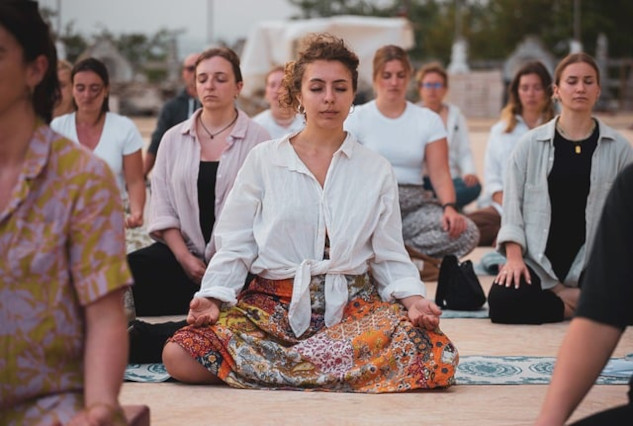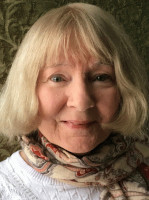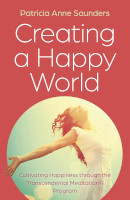
Image by vined mind
In This Article:
- What is collective consciousness and how it affects society.
- How reducing stress in collective consciousness can prevent conflicts.
- What Maharishi Mahesh Yogi said about collective consciousness and peace.
- How does the Maharishi Effect propose to influence societal conditions?
- What practical steps can societies take to harness the power of collective consciousness?
Understanding and Utilizing Collective Consciousness
by Patricia Anne Saunders.
All occurrences of violence, negativity, conflict, crises, or problems in any society “are just the expression of growth of stress in collective consciousness. When the level of stress becomes sufficiently great, it bursts out into large-scale violence, war, and civil uprising necessitating military action.” -- Maharishi Mahesh Yogi
Maharishi’s statement above is echoed by the film director and philanthropist David Lynch, who said,
“The problem of violence, at its source, is stress—the escalating buildup of political and societal stress in collective consciousness that fuels conflict and warfare ... The only solution is to reduce the stress in collective consciousness—in society as a whole. Truly, there is no other way.”
If the causes of conflict and violence lie in collective consciousness, then collective consciousness must be better understood.
Durkheim’s Collective Consciousness
The French sociologist Émile Durkheim coined the term collective consciousness, or conscience collective. Durkheim described it in this way:
“The totality of beliefs and sentiments common to average citizens of the same society forms a determinate system which has its own life; one may call it the collective or common conscience.”
He referred to collective consciousness as: a) being independent of the particular conditions in which the individuals are placed; and b) having properties, conditions of existence, and modes of development that are similar to those of individuals.
Durkheim also concluded, “In the large, happiness coincides with a healthy state,” which makes sense from the perspective that if the state is healthy, then it must be because the individuals who make up that state are healthy.
Shared Beliefs and Attitudes
Durkheim’s understanding of a conscience collective evolved into the modern understanding of collective consciousness as the shared beliefs, attitudes, and ideas that are a unifying force within a group, be it the military, society, or nation, or even the whole world.
It may be a cliché to say that the way we see the world depends on the emotional lens through which we view it, but it is true. Our world, our society, is as we are.
To change society, we must change ourselves because what we are produces the type of society we live in, the type of media that is prevalent, the political system, and even the type of medicine that is favored. The reason for this is that we pour our thoughts, feelings, and sentiments into a collective mix, a local or national collective consciousness that generates the way we live and the way that scientific discoveries, artistic expressions, and general ideas are interpreted and accepted.
To quote Maharishi, collective consciousness is “the essence of a nation that continues generation after generation.”
Cells Within Collective Consciousness
In the same way that a human being is made of trillions of cells, all of which contribute to the organs and tissues that make up the human body, society is made up of its own cells, the people who live in it, help to run it, and retire in it.
Each individual may not describe themselves as a cell in the body of society, they may not even be aware of the reasons why they act as they do, but they are contributing to collective consciousness all the same. That is why some towns have a tense feel about them and others have a harmonious and relaxed feel.
It is collective consciousness that determines whether society is unified, peaceful, and happy, or whether society is divided and disorderly, with continuous infighting, everyone afraid to say what they think and feel, and everyone afraid to deviate from the norm in creative pursuits. This does not produce a happy, united society at peace with itself and at peace with the rest of the world.
All for One and One for All
The military is not immune to the influence of collective consciousness. As the 5th century Chinese military commander Sun Tzu wrote in The Art of War,
“He will win whose army is animated by the same spirit throughout all its ranks.”
Here, Sun Tzu is clearly referring to the importance of unity in an army. Sun Tzu also emphasizes the importance of inspiring the army with unity of purpose. However, first and foremost, he believes that “supreme excellence consists in breaking the enemy’s resistance without fighting.”
For Sun Tzu, “the highest form of generalship is to balk the enemy’s plans; the next best is to prevent the junction of the enemy’s forces; the next in order is to attack the enemy’s army in the field.” As a military commander, he does not appear to rate fighting as highly as avoiding fighting, but avoiding fighting is easier said than done, judging by the large number of wars that have taken place since his time.
So how can we create a peaceful, happy nation, even a peaceful, happy world? When treaties last, and many do, then nations can sleep easily. Unfortunately, treaties can be unreliable in which case no one sleeps easily.
Insecure Treaties
The 1972 Biological Weapons Convention, a treaty that bans the production and use of biological and toxin weapons, was widely welcomed. Signatories of the treaty guaranteed never to develop, produce, stockpile, or otherwise acquire or retain:
- “...microbial or other biological agents, or toxins whatever their origin or method of production, of types and in quantities that have no justification for prophylactic, protective or other peaceful purposes weapons, equipment or means of delivery designed to use such agents or toxins for hostile purposes or in armed conflict.”
But even as the treaty was being signed, the Soviet Union was already planning a biological weapons research, development, and production program on a huge scale. By 2018, many governments, including those of the governments of the U.K., Canada, Israel, Germany, U.S., France, and Russia, were known to carry out covert research into bioweaponry.
The problem is that when one country begins research into biological weaponry, other countries feel they have to compete. The threat of bioweapons is also not the sole province of governments. The Japanese terrorist group Aum Shinrikyo carried out a deadly attack using sarin (a chemical nerve agent) attack on a Tokyo subway in 1987.
Even the 1968 Nuclear Non-Proliferation Treaty, which obligates nations to regulate the safe use of nuclear energy, prevent the spreading of nuclear weapons, and work toward nuclear disarmament, cannot be held to be completely reliable.
By 2006, there had already been violations of the treaty involving Iraq, Iran, Libya, and North Korea, hardly friends of the U.S. and its allies. Then again, in 2019, the U.S. and Russia pulled out of the Intermediate-Range Nuclear Forces Treaty, designed to ban missiles with ranges between 310 and 3,400 miles. At the time of writing, the president of the Russian Federation, Vladimir Putin, is threatening nuclear war. So much for disarmament. So much for the reliability of major treaties.
Given the reality of the world we live in, what more can we do to create a peaceful planet, bearing in mind that peace is the basis for happiness? As Sherlock Holmes said in The Sign of the Four, “Eliminate all other factors, and the one which remains must be the truth.” The truth, in this case, appears to be the Maharishi Effect.
The Maharishi Effect
If consciousness is all there is, then everything is connected. While it may seem difficult to reconcile this with everyday perception of the world, it becomes a lived experience in higher states of consciousness, and can be upheld by recent research on collective consciousness.
When the mind goes beyond every tiny thought and feeling and experiences deep peace, then the mind has expanded to the infinite level of the omnipresent Self, Transcendental Consciousness. In this very desirable state, higher brain wave coherence is generated, thus making us more coherent, peaceful, and capable of more orderly thinking and behavior.
By higher brain wave coherence, we mean that the different waves of the brain, alpha, beta, theta, gamma, are moving synchronously with each other. When this occurs in groups practicing the Transcendental Meditation and TM-Sidhi program, increased coherence radiates out into the collective consciousness.
This is known as the Maharishi Effect and results in a boost of orderly thinking in the population as a whole, which can soften the atmosphere and, according to the evidence, decrease crime and conflict.
The Maharishi Effect was named after Maharishi Mahesh Yogi who first predicted that Transcendental Meditation practice could influence the collective consciousness of society in a positive direction. As early as 1962, Maharishi stated:
“The day one-tenth of the adult population of the world begins to meditate a half-hour morning and evening and begins to emit an influence of peace and harmony from the deepest level of consciousness—from that day, the atmosphere of the world, this negative atmosphere of the world, will be neutralized, and from that day will dawn the chance of no war for centuries to come.”
Elsewhere, Maharishi is reported as saying that
“while 10% would be ideal, even if only 1% of the world’s population meditated it would be sufficient to do away with the hatred that causes war.”
There is a very simple reason why Transcendental Meditation has this effect, and it lies in our understanding of Transcendental Consciousness. Again, Maharishi states:
“Because consciousness is the basis of all that is there—here, there, and everywhere—it is the quantum level of life, the very basic level of life. If the attention reaches that level, what happens is like the small pebble falling on the silent bed of the water. A small pebble falls, creating impulses. These impulses reach all the far places and all the water. Just like that, when the conscious mind of one single individual transcends, we can imagine the thrills being created on that silent level of consciousness which is the omnipresent reality.
"This pulsating consciousness of the individual creates impulses of life all over, and because this is the very fundamental level of life of everyone, everyone’s thinking, everyone’s consciousness is influenced by that ... The whole society becomes more positive in its trends, more positive in its thinking. The awareness of the whole population is influenced tremendously. That is why the criminals change, negativity changes. A man thinking like that today, he thinks in a different way tomorrow.”
Copyright ©2024. All Rights Reserved.
Article Source:
Book: Creating a Happy World
Creating a Happy World: Cultivating Happiness through the Transcendental Meditation® Program
by Patricia Anne Saunders.
Click here for more info and/or to order this paperback book. Also available as a Kindle edition.
About the Author
 Patricia Anne Saunders studied music before training as a teacher of the Transcendental Meditation technique. She is now a Ph.D. researcher in the department of Maharishi Vedic Science at Maharishi University of Management, researching into consciousness and Vedic sound from the perspective of the Vedic tradition of knowledge.
Patricia Anne Saunders studied music before training as a teacher of the Transcendental Meditation technique. She is now a Ph.D. researcher in the department of Maharishi Vedic Science at Maharishi University of Management, researching into consciousness and Vedic sound from the perspective of the Vedic tradition of knowledge.
Article Recap:
The article discusses the concept of collective consciousness as explained by figures like Maharishi Mahesh Yogi and sociologist Émile Durkheim, highlighting its significant influence on societal peace and conflict. It delves into how collective emotional states can escalate into violence or create harmony, suggesting that elevating the collective consciousness through practices like Transcendental Meditation could lead to more peaceful societies. The piece also examines historical and theoretical perspectives on how collective beliefs shape societal outcomes and the potential of meditation to reduce societal stress and conflict.


























